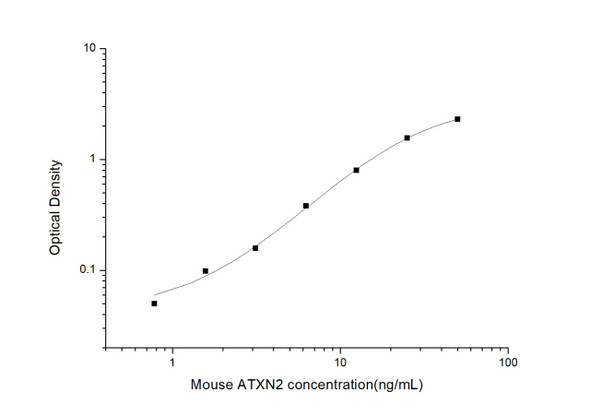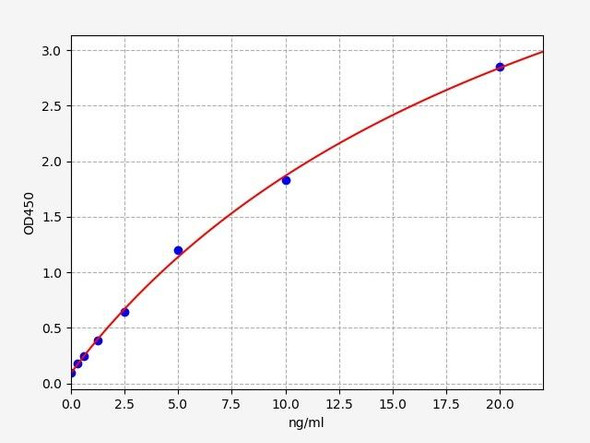Human Cell Biology ELISA Kits 6
Human ATXN2 (Ataxin 2) ELISA Kit (HUES01716)
- SKU:
- HUES01716
- Product Type:
- ELISA Kit
- Size:
- 96 Assays
- Uniprot:
- Q99700
- Sensitivity:
- 0.47ng/mL
- Range:
- 0.78-50ng/mL
- ELISA Type:
- Sandwich
- Synonyms:
- ASL13, ATX2, SCA2, TNRC13
- Reactivity:
- Human
- Sample Type:
- Serum, plasma and other biological fluids
- Research Area:
- Cell Biology
Description
| Assay type: | Sandwich |
| Format: | 96T |
| Assay time: | 4.5h |
| Reactivity: | Human |
| Detection Method: | Colormetric |
| Detection Range: | 0.78-50 ng/mL |
| Sensitivity: | 0.47 ng/mL |
| Sample Volume Required Per Well: | 100µL |
| Sample Type: | Serum, plasma and other biological fluids |
| Specificity: | This kit recognizes Human ATXN2 in samples. No significant cross-reactivity or interference between Human ATXN2 and analogues was observed. |
This ELISA kit uses Sandwich-ELISA as the method. The micro ELISA plate provided in this kit has been pre-coated with an antibody specific to Human ATXN2. Standards or samples are added to the appropriate micro ELISA plate wells and combined with the specific antibody. Then a biotinylated detection antibody specific for Human ATXN2 and Avidin-Horseradish Peroxidase (HRP) conjugate are added to each micro plate well successively and incubated. Free components are washed away. The substrate solution is added to each well. Only those wells that contain Human ATXN2, biotinylated detection antibody and Avidin-HRP conjugate will appear blue in color. The enzyme-substrate reaction is terminated by adding Stop Solution and the color turns yellow. The optical density (OD) is measured spectrophotometrically at a wavelength of 450 nm ± 2 nm. The OD value is proportional to the concentration of Human ATXN2. The concentration of Human ATXN2 in samples can be calculated by comparing the OD of the samples to the standard curve.
| UniProt Protein Function: | ataxin-2: Involved in EGFR trafficking, acting as negative regulator of endocytic EGFR internalization at the plasma membrane. Defects in ATXN2 are the cause of spinocerebellar ataxia type 2 (SCA2); also known as olivopontocerebellar atrophy II (OPCA II or OPCA2). Spinocerebellar ataxia is a clinically and genetically heterogeneous group of cerebellar disorders. Patients show progressive incoordination of gait and often poor coordination of hands, speech and eye movements, due to cerebellum degeneration with variable involvement of the brainstem and spinal cord. SCA2 belongs to the autosomal dominant cerebellar ataxias type I (ADCA I) which are characterized by cerebellar ataxia in combination with additional clinical features like optic atrophy, ophthalmoplegia, bulbar and extrapyramidal signs, peripheral neuropathy and dementia. SCA2 is characterized by hyporeflexia, myoclonus and action tremor and dopamine-responsive parkinsonism. SCA2 is caused by expansion of a CAG repeat resulting in about 36 to 52 repeats in some patients. Longer expansions result in earlier the expansion, onset of the disease. Defects in ATXN2 are a cause of susceptibility to amyotrophic lateral sclerosis type 13 (ALS13). It is a neurodegenerative disorder affecting upper motor neurons in the brain and lower motor neurons in the brain stem and spinal cord, resulting in fatal paralysis. Sensory abnormalities are absent. Death usually occurs within 2 to 5 years. The etiology of amyotrophic lateral sclerosis is likely to be multifactorial, involving both genetic and environmental factors. The disease is inherited in 5-10% of the cases. An increased risk for developing amyotrophic lateral sclerosis is seems to be conferred by CAG repeat intermediate expansions greater than 23 but below the threshold for developing spinocerebellar ataxia. Belongs to the ataxin-2 family. 4 isoforms of the human protein are produced by alternative splicing. |
| UniProt Protein Details: | Protein type:Translation; RNA-binding Chromosomal Location of Human Ortholog: 12q24. 1 Cellular Component: cytoplasm; Golgi apparatus; membrane; nucleoplasm; perinuclear region of cytoplasm; polysome; ribonucleoprotein complex; stress granule; trans-Golgi network Molecular Function:epidermal growth factor receptor binding; protein binding; protein C-terminus binding Biological Process: cytoplasmic mRNA processing body assembly; negative regulation of receptor internalization; stress granule assembly Disease: Parkinson Disease, Late-onset; Spinocerebellar Ataxia 2 |
| NCBI Summary: | This gene belongs to a group of genes that is associated with microsatellite-expansion diseases, a class of neurological and neuromuscular disorders caused by expansion of short stretches of repetitive DNA. The protein encoded by this gene has two globular domains near the N-terminus, one of which contains a clathrin-mediated trans-Golgi signal and an endoplasmic reticulum exit signal. The protein is primarily localized to the Golgi apparatus, with deletion of the Golgi and endoplasmic reticulum signals resulting in abnormal subcellular localization. In addition, the N-terminal region contains a polyglutamine tract of 14-31 residues that can be expanded in the pathogenic state to 32-200 residues. Intermediate length expansions of this tract increase susceptibility to amyotrophic lateral sclerosis, while long expansions of this tract result in spinocerebellar ataxia-2, an autosomal-dominantly inherited, neurodegenerative disorder. Alternative splicing results in multiple transcript variants. [provided by RefSeq, Jul 2016] |
| UniProt Code: | Q99700 |
| NCBI GenInfo Identifier: | 215273941 |
| NCBI Gene ID: | 6311 |
| NCBI Accession: | Q99700. 2 |
| UniProt Secondary Accession: | Q99700,Q24JQ7, Q6ZQZ7, Q99493, A6NLD4, |
| UniProt Related Accession: | Q99700 |
| Molecular Weight: | 109,037 Da |
| NCBI Full Name: | Ataxin-2 |
| NCBI Synonym Full Names: | ataxin 2 |
| NCBI Official Symbol: | ATXN2 |
| NCBI Official Synonym Symbols: | ATX2; SCA2; ASL13; TNRC13 |
| NCBI Protein Information: | ataxin-2 |
| UniProt Protein Name: | Ataxin-2 |
| UniProt Synonym Protein Names: | Spinocerebellar ataxia type 2 protein; Trinucleotide repeat-containing gene 13 protein |
| Protein Family: | Ataxin |
| UniProt Gene Name: | ATXN2 |
| UniProt Entry Name: | ATX2_HUMAN |
As the OD values of the standard curve may vary according to the conditions of the actual assay performance (e. g. operator, pipetting technique, washing technique or temperature effects), the operator should establish a standard curve for each test. Typical standard curve and data is provided below for reference only.
| Concentration (ng/mL) | O.D | Average | Corrected |
| 50 | 2.511 2.547 | 2.529 | 2.473 |
| 25 | 1.615 1.647 | 1.631 | 1.575 |
| 12.5 | 0.956 0.92 | 0.938 | 0.882 |
| 6.25 | 0.485 0.505 | 0.495 | 0.439 |
| 3.13 | 0.282 0.262 | 0.272 | 0.216 |
| 1.57 | 0.172 0.152 | 0.162 | 0.106 |
| 0.78 | 0.104 0.116 | 0.11 | 0.054 |
| 0 | 0.049 0.063 | 0.056 | -- |
Precision
Intra-assay Precision (Precision within an assay): 3 samples with low, mid range and high level Human ATXN2 were tested 20 times on one plate, respectively.
Inter-assay Precision (Precision between assays): 3 samples with low, mid range and high level Human ATXN2 were tested on 3 different plates, 20 replicates in each plate.
| Intra-assay Precision | Inter-assay Precision | |||||
| Sample | 1 | 2 | 3 | 1 | 2 | 3 |
| n | 20 | 20 | 20 | 20 | 20 | 20 |
| Mean (ng/mL) | 2.67 | 4.90 | 22.65 | 2.75 | 5.10 | 21.61 |
| Standard deviation | 0.15 | 0.25 | 0.83 | 0.15 | 0.29 | 0.67 |
| C V (%) | 5.62 | 5.10 | 3.66 | 5.45 | 5.69 | 3.10 |
Recovery
The recovery of Human ATXN2 spiked at three different levels in samples throughout the range of the assay was evaluated in various matrices.
| Sample Type | Range (%) | Average Recovery (%) |
| Serum (n=5) | 93-107 | 100 |
| EDTA plasma (n=5) | 91-107 | 98 |
| Cell culture media (n=5) | 91-104 | 97 |
Linearity
Samples were spiked with high concentrations of Human ATXN2 and diluted with Reference Standard & Sample Diluent to produce samples with values within the range of the assay.
| Serum (n=5) | EDTA plasma (n=5) | Cell culture media (n=5) | ||
| 1:2 | Range (%) | 94-109 | 93-106 | 88-104 |
| Average (%) | 101 | 100 | 95 | |
| 1:4 | Range (%) | 93-108 | 87-102 | 86-97 |
| Average (%) | 98 | 93 | 91 | |
| 1:8 | Range (%) | 91-102 | 86-100 | 81-95 |
| Average (%) | 97 | 92 | 87 | |
| 1:16 | Range (%) | 90-105 | 84-96 | 83-95 |
| Average (%) | 96 | 89 | 90 |
An unopened kit can be stored at 4°C for 1 month. If the kit is not used within 1 month, store the items separately according to the following conditions once the kit is received.
| Item | Specifications | Storage |
| Micro ELISA Plate(Dismountable) | 8 wells ×12 strips | -20°C, 6 months |
| Reference Standard | 2 vials | |
| Concentrated Biotinylated Detection Ab (100×) | 1 vial, 120 µL | |
| Concentrated HRP Conjugate (100×) | 1 vial, 120 µL | -20°C(shading light), 6 months |
| Reference Standard & Sample Diluent | 1 vial, 20 mL | 4°C, 6 months |
| Biotinylated Detection Ab Diluent | 1 vial, 14 mL | |
| HRP Conjugate Diluent | 1 vial, 14 mL | |
| Concentrated Wash Buffer (25×) | 1 vial, 30 mL | |
| Substrate Reagent | 1 vial, 10 mL | 4°C(shading light) |
| Stop Solution | 1 vial, 10 mL | 4°C |
| Plate Sealer | 5 pieces | |
| Product Description | 1 copy | |
| Certificate of Analysis | 1 copy |
- Set standard, test sample and control (zero) wells on the pre-coated plate and record theirpositions. It is recommended to measure each standard and sample in duplicate. Note: addall solutions to the bottom of the plate wells while avoiding contact with the well walls. Ensuresolutions do not foam when adding to the wells.
- Aliquot 100 µL of standard solutions into the standard wells.
- Add 100 µL of Sample / Standard dilution buffer into the control (zero) well.
- Add 100 µL of properly diluted sample (serum, plasma, tissue homogenates and otherbiological fluids) into test sample wells.
- Cover the plate with the sealer provided in the kit and incubate for 90 min at 37 °C.
- Aspirate the liquid from each well, do not wash. Immediately add 100 µL of BiotinylatedDetection Ab working solution to each well. Cover the plate with a plate seal and gently mix. Incubate for 1 hour at 37 °C.
- Aspirate or decant the solution from the plate and add 350 µL of wash buffer to each welland incubate for 1-2 minutes at room temperature. Aspirate the solution from each well andclap the plate on absorbent filter paper to dry. Repeat this process 3 times. Note: a microplatewasher can be used in this step and other wash steps.
- Add 100 µL of HRP Conjugate working solution to each well. Cover with a plate seal andincubate for 30 min at 37 °C.
- Aspirate or decant the solution from each well. Repeat the wash process for five times asconducted in step 7.
- Add 90 µL of Substrate Reagent to each well. Cover with a new plate seal and incubate forapproximately 15 min at 37 °C. Protect the plate from light. Note: the reaction time can beshortened or extended according to the actual color change, but not by more than 30min.
- Add 50 µL of Stop Solution to each well. Note: Adding the stop solution should be done inthe same order as the substrate solution.
- Determine the optical density (OD value) of each well immediately with a microplate readerset at 450 nm.






